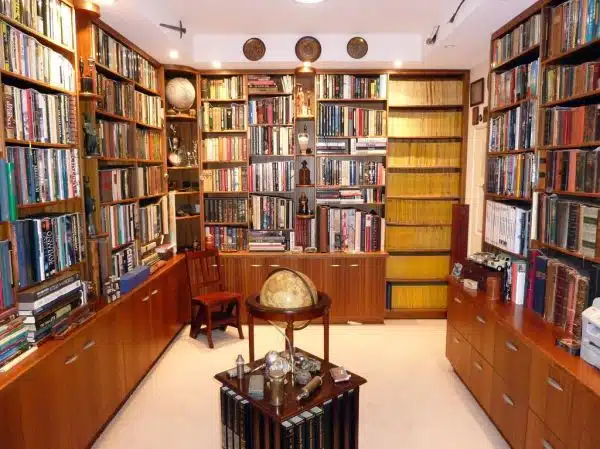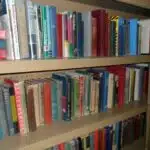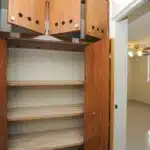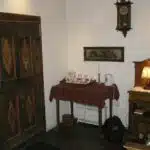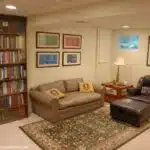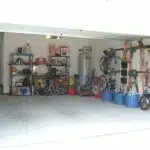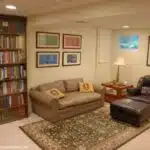A home library is an essential part of a household for those who have a passion for reading and learning. However, creating a personal library can be challenging and expensive. The cost of acquiring books, shelves, and other resources can quickly add up, making it difficult to establish a comprehensive collection. Nevertheless, there are ways to create an inexpensive home library by utilizing various resources available in the community.
In this article, we will explore some practical ideas for building an affordable home library that requires minimal financial investment. We will discuss how to find free or low-cost books, ways to organize your collection on a budget, and how to leverage technology to access digital content. By following these suggestions, you can create a personal library that not only satisfies your intellectual curiosity but also serves as a valuable resource for your family and friends.
Assessing Your Reading Needs And Preferences
In the age of digital media, it can be easy to forget the importance of having a physical library within your home. However, for those who value literature and wish to create an inexpensive home library, there are several factors to consider before diving in. Firstly, it’s important to assess your reading needs and preferences in order to build a collection that suits you best.
Book format preferences will play a crucial role in your selection process. Do you prefer hardcovers or paperbacks? Are you drawn towards graphic novels or classics? Understanding what book formats you enjoy most will help guide your purchases and ensure that you have a collection that you’ll actually want to read from. Similarly, looking at your frequency habits is key – do you read often enough to justify purchasing multiple books each month? Or would it make more sense for you to slowly build up your collection over time?
Ultimately, understanding these two aspects will help guide the creation of an inexpensive home library that suits both your practical and personal needs. As we move on to deciding on a library theme or focus, keep these considerations in mind as they will help inform future purchases and ensure that your library remains relevant and enjoyable for years to come.
Deciding On A Library Theme Or Focus
1.When deciding on a library theme or focus, decorating ideas should be considered in order to create an inviting environment.
2.Selecting books for the library should be done intentionally in order to best serve the library’s theme or focus.
3.When considering the decor of the library, factors such as the library’s size, the desired atmosphere, and available resources should be taken into account.
4.When selecting books for the library, the interests of the intended users, the library’s theme or focus, and the available budget should be kept in mind.
Decorating Ideas
Creating a home library is a fulfilling and exciting project for book lovers. The process of choosing a library theme or focus can be overwhelming, but there are many decorating ideas to help bring your vision to life. Color schemes and furniture arrangement are two key elements in creating an inexpensive yet stylish home library.
When selecting a color scheme for your library, consider the mood you want to create. If you’re after a cozy and comfortable atmosphere, warm colors like brown, orange, or red may be ideal. Alternatively, if you prefer a calm and peaceful space, cool colors such as blue or green may work best. When it comes to furniture arrangement, remember that simplicity is key. Start with bookshelves placed against the wall and add seating options like armchairs or bean bags for comfort while reading.
Another decorating idea for an inexpensive home library is repurposing old furniture. A simple coat of paint can transform an old dresser into a unique bookshelf or a coffee table into an inviting reading nook. Additionally, consider adding personal touches such as family photos or artwork to make the space feel more personalized.
In conclusion, creating an inexpensive home library can be achieved through careful consideration of color schemes and furniture arrangement. Repurposing old furniture and adding personal touches can also help bring your vision to life without breaking the bank. With these decorating ideas in mind, you’ll have a cozy and inviting space to enjoy your favorite books in no time.
Book Selection
When deciding on a library theme or focus, one of the most important aspects to consider is book selection. Book selection is an essential part of creating a home library that reflects your personal taste and interests. As a professional librarian, it is my duty to ensure that the books in our collection meet the needs of our patrons.
One approach to book selection is choosing books based on genre. This can help create a cohesive theme for your library and make it easier to organize your shelves. For example, if you enjoy mystery novels, you may want to focus on collecting books from that genre. However, it’s important not to limit yourself too much and include a variety of genres to keep things interesting.
Another factor to consider when selecting books for your home library is personal taste. While it’s important to have a diverse collection that appeals to a wide range of readers, it’s also vital that the books reflect your own interests and passions. This will make your library feel more personalized and enjoyable for you and any guests who visit. As a librarian, I always encourage people to read what they love and follow their own reading journey, even if it means collecting books outside of popular trends or bestseller lists.
In summary, book selection plays a critical role in creating an engaging and fulfilling home library experience. By considering both genre and personal taste when selecting books, you can create a collection that reflects your unique style while still appealing to others who visit your space. Remember, there are no right or wrong choices when it comes to building your library – just choose what speaks to you!
Repurposing Existing Furniture And Spaces For Your Library
After deciding on a library theme or focus, the next step in creating an inexpensive home library is to repurpose existing furniture and spaces. This can be done in various creative ways that offer space-saving solutions. Repurposing furniture is an excellent way to save money while also adding character to your library. Instead of buying new shelves, consider using old bookcases or wooden crates that you can paint or decorate to match your theme.
DIY library decor is another great option for those who want to add some personalized touches and create a unique atmosphere. There are many easy and affordable projects available online that you can do yourself, such as creating book page art, making bookmarks, or painting quotes on old frames. These projects not only save money but also add a personal touch to your library.
Incorporating repurposed furniture and DIY decor into your home library is an excellent way to create a cozy reading nook without breaking the bank. By using what you already have or finding low-cost options at thrift stores or garage sales, you can turn any room into a peaceful retreat for reading and relaxation.
Moving forward, finding free or low-cost books at local libraries and bookstores is the next step in building an inexpensive home library. With a little creativity and resourcefulness, you can fill your shelves with books without spending a fortune.
Finding Free Or Low-Cost Books At Local Libraries And Bookstores
Local libraries and bookstores can be a great resource for finding free or low-cost books for your home library. Many libraries offer book donation programs where individuals can donate their gently used books for others to enjoy. In return, the library will often offer these donated books for sale at a reduced price, with the proceeds going towards supporting library programs and services.
Book exchanges are another way to find free or low-cost books. These exchanges can take place at libraries, community centers, or even through online platforms. The idea behind a book exchange is that individuals bring in books they no longer want and trade them with others for new-to-them titles. This not only helps build personal home libraries but also promotes community sharing and recycling.
Some bookstores may also offer low-cost options such as clearance sections or used book sales. Often times these sales are held to make room for new inventory and the prices of these books can be significantly reduced. While it may take some time to sift through the selection, you never know what hidden gems you may find at a discounted price.
- Check with your local library about their book donation program.
- Attend community book exchanges to meet other readers and expand your collection.
- Look for clearance sections or used book sales at local bookstores.
- Consider donating your own gently used books to help support library programs and services.
Next, we will explore online book swapping and trading communities as another option for building an inexpensive home library.
Exploring Online Book Swapping And Trading Communities
A wise old librarian once said that books are like friends, you can never have too many. However, accumulating books can be an expensive affair. This is where online book swapping and trading communities come in handy. These platforms provide a cost-effective way of acquiring new reading material while connecting with other bibliophiles.
Before delving into the world of online book swapping and trading, it is important to understand book trading etiquette. It is crucial to ensure that the books being traded are in good condition, free of any markings or damages. Additionally, it is important to communicate clearly with the other party regarding shipping arrangements and timelines. To avoid disappointment, it is also advisable to verify the credibility of the person you are trading with.
In addition to swapping and trading communities, joining an online book club can be a great way to discover new titles and connect with readers who share similar interests. These clubs offer a platform for discussions and recommendations on various literary works. Some popular online book club suggestions include Goodreads, Oprah’s Book Club, and Reese Witherspoon’s Book Club. By becoming a member of these clubs, one can access a plethora of reading material from fellow members without breaking the bank.
| Pros | Cons |
|---|---|
| Cost-effective | Limited selection |
| Connects you with other readers | Risk of receiving damaged goods |
| Access to a variety of genres | Requires time and effort |
As much as online book swapping and trading provides an affordable way to expand your home library collection, there are also alternative ways to acquire books at bargain prices. Attending book sales and thrift stores for deals is another viable option worth exploring. These avenues not only offer access to affordable books but also provide opportunities for supporting local charities through purchases made at such sales events or stores.
Attending Book Sales And Thrift Stores For Deals
Book sale strategies and thrift store treasures are often overlooked when building a home library. However, these can be excellent sources for finding affordable books to add to your collection. Here are some tips to keep in mind when attending book sales and thrift stores.
Firstly, arrive early to book sales. Most book sales start on a Friday or Saturday morning, but it’s best to check the schedule ahead of time so you can be there when the doors open. This increases your chances of finding rare and valuable books before they’re snatched up by other buyers. Additionally, bring a tote bag or box with you to carry your purchases since most book sales don’t provide bags.
Secondly, don’t overlook thrift stores when searching for books. Thrift stores typically have a section dedicated to books that are sold at very low prices. It’s important to take your time and browse through the selection as you never know what hidden gems you may find. Additionally, if you’re looking for specific titles, ask the staff if they have any in stock that haven’t been put out on display yet.
Lastly, it’s important to have patience and persistence when searching for deals at book sales and thrift stores. These locations can sometimes be overwhelming with their vast collections of books, but taking the time to sort through them can lead to great finds that will enhance your home library.
Incorporating book sale strategies and thrift store treasures into your search for affordable books is an excellent way to build an impressive home library without breaking the bank. However, there are also digital options available for those who prefer e-books or audiobooks. Utilizing ebook and audiobook services for digital content is the next step in creating a well-rounded home library that caters to all reading preferences.
Utilizing Ebook And Audiobook Services For Digital Content
eBook services provide access to a wide range of digital content, including books, magazines, and newspapers, often at a fraction of the cost of physical copies. Audiobook services provide a convenient way to access audio recordings of books, allowing for greater accessibility for those with visual impairments or who prefer to listen. Digital content from both eBook and Audiobook services is often more cost-effective than physical copies, making it an attractive option for creating a home library. Many eBook and Audiobook services are also accessible on mobile devices and other digital platforms, providing an easy and convenient way to access content.
Ebook Services
As a librarian, it is important to provide access to digital content for patrons who may not have the means or space for physical books. eBook services have become a popular option due to their convenience and affordability. Comparing prices between different services can help patrons find the best deals and save money.
When looking for the best ebook services for specific genres, it is important to consider factors such as selection, availability, and compatibility with different devices. Some popular options include Amazon Kindle Unlimited, Scribd, and Overdrive/Libby (which allows users to borrow ebooks from their local library). Each service offers its own unique advantages and disadvantages, so it’s important to research and compare before making a decision.
Overall, utilizing ebook services is a cost-effective way to build a home library without breaking the bank. With a little bit of research and comparison shopping, patrons can find the best deals and access a wide variety of digital content in their preferred genres. As librarians, it is our duty to assist patrons in finding resources that meet both their informational and budgetary needs.
Audiobook Services
As librarians, we are constantly exploring subscription and renting services to provide our patrons with different options for accessing digital content. While eBook services have become a popular choice for many readers, audiobook services are also gaining popularity due to their convenience and flexibility. Utilizing audiobook services is particularly helpful for patrons who prefer listening over reading, or those who have visual impairments.
When comparing audiobook platforms, it is important to consider factors such as selection, availability, and compatibility with different devices. Some popular options include Audible, Scribd, and Overdrive/Libby (which allows users to borrow audiobooks from their local library). Each service offers its own unique advantages and disadvantages, so it’s important to research and compare before making a decision.
Overall, utilizing audiobook services is an excellent way to build a home library of digital content. With a little bit of research and comparison shopping, patrons can find the best deals and access a wide variety of audiobooks in their preferred genres. As librarians, it is our responsibility to assist patrons in finding resources that meet both their informational and budgetary needs.
Building Your Own Bookshelves And Storage Solutions
A home library can be the perfect place to escape from the world and immerse yourself in a good book. Creating an inexpensive library can be done through DIY bookshelf designs and space-saving storage options. Building your own bookshelves not only saves money but also allows you to customize them to fit your specific needs.
When it comes to DIY bookshelf designs, there are countless options available. Some popular choices include ladder shelves, floating shelves, and modular shelving units. Ladder shelves are great for small spaces as they take up minimal floor space while providing ample storage. Floating shelves are another space-saving option that can be easily mounted on walls, creating a sleek and modern look. Modular shelving units offer versatility as they can be rearranged and added onto as your collection grows.
In addition to building your own bookshelves, there are also various space-saving storage options available. Some examples include under-bed storage containers, hanging organizers, and ottoman storage benches. Utilizing these options not only helps keep your books organized but also frees up valuable floor space in your home. By combining DIY bookshelf designs with space-saving storage options, you can create an inexpensive home library that is both functional and aesthetically pleasing.
To fully enjoy your home library, organizing your collection by genre, author, or topic is essential. In the next section, we will discuss different methods for organizing and cataloging your books to ensure easy access and enjoyment of your reading materials.
Organizing Your Collection By Genre, Author, Or Topic
Having built your own bookshelves and storage solutions, the next step is organizing your collection. This is where the fun begins! Organizing your books will not only make it easier to find them but also give your library an aesthetic appeal.
One way of organizing your books is by color coding or alphabetical order. Color coding is a popular choice for those who want to add some flair to their bookshelves. By arranging books according to their spine colors, you can create a visually stunning display that compliments your room decor. On the other hand, if you prefer a more traditional approach, alphabetical order may be the way to go. This method allows you to easily locate any book in your collection as they are arranged based on author names or titles.
Another way of organizing your books is by series categorization or literary movements. If you have many books that are part of a series, it makes sense to keep them together for easy access. Similarly, if you are interested in specific literary movements such as romanticism or modernism, grouping books according to these categories can help you find related works quickly.
With all these methods at your disposal, creating a cataloging system for easy access and reference should be straightforward. Whether using software like LibraryThing or creating a simple spreadsheet with information about each book, having a cataloging system will save time and ensure that you know what books you have in your collection. The key is finding what works best for you and sticking with it!
Creating A Cataloging System For Easy Access And Reference
- A cataloging system is an essential tool for organizing a library and making it easy to access and reference.
- A library can be organized by genre, subject, and author in order to easily find books and other materials.
- Tracking library inventory is a necessary component of the cataloging system in order to keep track of items in the library.
- Establishing a card catalog is a useful tool to help patrons locate items and to quickly identify what materials are available.
- A cataloging system should be user-friendly and organized to ensure efficient access to library materials.
- Having a cataloging system in place is essential for maintaining an effective and efficient library.
Organizing By Genre
One effective way to organize a home library is by genre. Grouping books by their respective genres creates an efficient cataloging system that makes it easy for readers to locate specific titles. To further enhance this technique, color coding and alphabetical order can be employed. Color coding involves assigning a specific color to each genre while alphabetical order organizes books within the same genre alphabetically by author’s last name. This method ensures that the reader knows exactly where each book belongs in the library.
Another approach to organizing a home library is by chronological order. This system arranges books according to publication date, allowing readers to observe the evolution of literary works over time. Additionally, this method makes it easier for readers to locate a particular title within a series or from an author who has written multiple books on the same subject matter. On the other hand, organizing books by reading level is ideal for families with children. By categorizing books into different levels based on age and skill level, young readers are encouraged to read more and are presented with appropriate reading materials.
In conclusion, organizing home libraries provides easy access and reference for avid readers and book lovers alike. Utilizing techniques such as genre grouping with color coding and alphabetical order or arranging books chronologically or by reading level enhances the overall experience of owning a personal library. Regardless of which organizational system one chooses, it is crucial to maintain consistency in implementation for optimal results in creating an inexpensive yet efficient home library.
Subject
The benefits of reading and the importance of literacy cannot be overstated, which is why creating a cataloging system for easy access and reference in a home library is crucial. As a professional librarian, one must consider the different ways to organize books in order to cater to the diverse needs of readers. While genre grouping with color coding and alphabetical order, chronological order, and reading level categorization are all effective methods, another approach that can be considered is organizing books by subject.
Organizing books by subject involves classifying books based on their content or topic. This method simplifies the process of finding specific information or resources within the library. For instance, if one has an extensive collection of cookbooks, they can group them together under ‘Cooking’ rather than mixing them up with other genres. Similarly, if one has several books on history from various time periods and regions around the world, organizing them under ‘History’ ensures that they are easier to find when needed.
The benefits of organizing books by subject extend beyond easy access and reference. It also encourages readers to explore different topics and broaden their knowledge base. Additionally, it promotes literacy as it enables individuals to discover new authors and titles that they may have otherwise overlooked. Ultimately, creating a cataloging system for easy access and reference serves not only as an efficient way to manage personal libraries but also as a tool for continuous learning and growth in the pursuit of knowledge.
Author
As a professional librarian, one of the key considerations in creating a cataloging system for easy access and reference is the author. While it may seem like an obvious factor to consider, it plays a significant role in organizing books effectively. To begin with, authors often have inspirations that shape their writing and define their style. By categorizing books according to author, readers can discover new titles that align with their interests and preferences.
Another way to organize books by author is through interviews or reviews. This approach involves grouping books together based on the author’s interviews or reviews that they have received. For example, if an author has written several novels, readers can group them together under ‘Fiction’ category and then sub-categorize them by interviewing each author about their works. Alternatively, if an author has written various non-fiction books on similar topics, these can be grouped together under ‘Non-Fiction’ category and then organized based on interview responses.
In conclusion, organizing books by author provides readers with efficient access to specific titles and helps them explore new authors and genres. Whether grouping books based on inspiration or interviews/reviews, categorizing books by author offers an engaging and effective way to manage personal libraries while promoting continuous learning and growth in the pursuit of knowledge. As professional librarians, it is our responsibility to provide readers with easy access to information that enriches their lives and empowers them towards serving others.
Incorporating Decorative Elements To Enhance Your Library’s Ambience
Decorative elements can enhance the ambiance of your home library, making it a more inviting and comfortable space for reading and relaxation. One important aspect to consider is lighting options. Adequate lighting is essential for reading, but you may also want to incorporate ambient or accent lighting to create a warm and cozy atmosphere. Consider using table lamps, floor lamps, or wall sconces to add visual interest and depth to your library’s decor.
Another key factor in creating an inviting environment is choosing a color scheme that complements the space. Soft, neutral colors such as beige, gray, or cream can create a calming effect, while bold hues like red or blue can add energy and vibrancy. You may also want to consider incorporating patterns or textures through curtains, rugs, or throw pillows. Whatever color scheme you choose should reflect your personal style while also creating an atmosphere conducive to relaxation and reflection.
By incorporating lighting options and carefully selecting a color scheme that complements your space, you can elevate the ambiance of your home library to another level. These decorative elements not only make your library visually appealing but also create a sense of peacefulness and tranquility that enhances the overall reading experience. In the next section, we will explore how you can take this one step further by hosting book club meetings and discussion groups in your home library.
Hosting Book Club Meetings And Discussion Groups
Incorporating decorative elements in your home library can create a cozy and inviting atmosphere for reading, but it’s not the only way to make the most of your collection. Book selection plays a crucial role in creating a fulfilling reading experience, and hosting book club meetings or discussion groups can be an excellent way to share your love of books with others.
When selecting books for your library, consider not only your personal interests but also those of potential guests. Including a variety of genres can appeal to a broader audience and spark engaging discussions. It’s also essential to keep up with new releases and bestsellers to ensure that your collection remains relevant and exciting.
Hosting book club meetings or discussion groups requires careful planning and logistics. Consider the size of your space, seating arrangements, and refreshments. It’s also important to establish ground rules regarding discussion topics, timing, and etiquette. By setting clear expectations from the start, you can ensure that everyone has an enjoyable and respectful experience.
Sharing your collection with friends and neighbors can be an enriching experience for all involved. Whether through lending or hosting book clubs, expanding your literary community allows for diverse perspectives and insights into different cultures and experiences. With thoughtful book selection and effective meeting logistics, you can create meaningful connections through shared reading experiences.
Sharing Your Collection With Friends And Neighbors
To build your home library, you have invested time and money into selecting books that interest you. But why keep these books to yourself when you can share them with others? One way to do this is through book exchanges. A book exchange allows people in the community to share their books with each other by trading titles they have already read for new ones. This way, everyone gets a chance to read something new without having to spend any extra money.
Community events are also an excellent way to share your collection with others. You can organize book clubs or reading groups where people can come together and discuss their favorite books. These events not only allow you to share your collection but also encourage a love of reading within the community. Additionally, you could participate in local charity events by donating some of your books.
Sharing your home library with friends and neighbors is a great way to give back to the community while also enjoying the benefits of being part of it. Whether it’s through book exchanges or community events, there are many ways to share your love of reading with others around you. In the next section, we’ll discuss how proper care and maintenance can help ensure that your home library stays in good condition for years to come.
Maintaining Your Library With Proper Care And Maintenance
Sharing your collection with friends and neighbors is a great way to foster a sense of community and spread the joy of reading. However, it is equally important to maintain proper care and preservation techniques for your personal library. Book preservation techniques include keeping books away from direct sunlight, avoiding exposure to moisture or extreme temperatures, and handling them carefully to prevent damage. It is also important to regularly dust and clean your bookshelves to prevent the accumulation of dirt or debris.
Creating a cozy reading nook can enhance the overall experience of reading at home. This can be achieved by incorporating comfortable seating, soft lighting, and decorative accents such as throw pillows or blankets. Additionally, organizing your books in a visually appealing manner can add to the ambiance of your reading space. Consider arranging them by color or size, or grouping them by genre or author.
Expanding your collection over time with a sustainable approach involves being mindful of your budget and choosing books that you will truly enjoy and appreciate. Consider visiting local used bookstores or participating in book swaps with friends or online communities. It is also helpful to prioritize purchasing books that align with your interests and values, rather than simply buying popular titles that may not hold long-term appeal. By taking these steps, you can continue to build upon your home library while maintaining a thoughtful and intentional approach.
Expanding Your Collection Over Time With A Sustainable Approach
Creating an inexpensive home library is a great way to nourish your mind, expand your knowledge, and indulge in the pleasure of reading. But, building a quality collection takes time, effort, and money. To expand your collection over time with a sustainable approach, you need to adopt some strategic habits that can help you save money and acquire books without compromising on quality.
One of the first things to consider when expanding your home library is whether you want to rent or buy books. Renting books can be an excellent option if you are on a tight budget and don’t want to invest much upfront. Many local libraries offer free book rentals that can help you build your collection over time. You can also explore online platforms like BookRental.com or Chegg.com that offer affordable rental options for different genres and categories. However, if you want to own books for long-term use or personalization, buying them may be more suitable.
Another sustainable option for expanding your home library is borrowing from friends or family members who share similar interests in reading as yours. Borrowing creates an opportunity for sharing knowledge, exploring new genres, and creating deeper bonds with loved ones. It’s also a cost-effective way of adding new titles to your collection without spending any money. Furthermore, borrowing allows you to test out books before deciding whether or not to purchase them for yourself.
In conclusion, expanding your home library with a sustainable approach requires careful planning and discipline. Whether it’s renting vs buying or borrowing from friends and family members, there are several ways to acquire quality books without breaking the bank. By adopting these habits and staying committed to building an excellent collection over time, you can make reading a lifelong habit that enriches your life in countless ways.
Tips for Expanding Your Home Library:
- Create a wishlist of titles that interest you.
- Participate in book swaps with other avid readers.
- Attend book fairs and sales for discounted titles.
- Subscribe to newsletters of publishing houses for updates on new releases.
Conclusion
Creating an inexpensive home library can be a fulfilling and rewarding experience for anyone who loves to read. By assessing your reading needs and preferences, deciding on a library theme or focus, repurposing existing furniture and spaces, finding free or low-cost books, exploring online book swapping communities, hosting book club meetings, sharing your collection with others, maintaining proper care and maintenance of your books, and expanding your collection over time with a sustainable approach – you can build an impressive library without breaking the bank.
According to recent studies conducted by the National Endowment for the Arts (NEA), reading rates in America have been declining steadily for several years. In fact, only 43% of adults in America reported reading literature in their leisure time in 2017. This is a concerning trend as studies have shown that reading has numerous cognitive benefits including improved vocabulary, empathy skills, and critical thinking abilities. Therefore, building a home library not only provides access to great literature but also creates an environment that encourages reading – something that is essential for personal growth and development.
In conclusion, creating an inexpensive home library is possible regardless of budget constraints. By following the steps outlined above and being mindful of sustainability practices such as using recycled materials whenever possible – anyone can create a space that promotes literacy and lifelong learning. As librarians, we encourage everyone to take up this endeavor not just for their own sake but also as a way to contribute positively towards society’s intellectual growth.
Image Credits
- “Private home reference library” by warwick_carter (featured)

